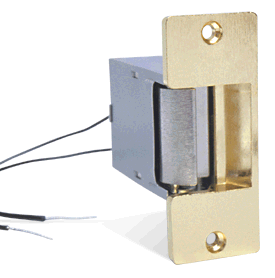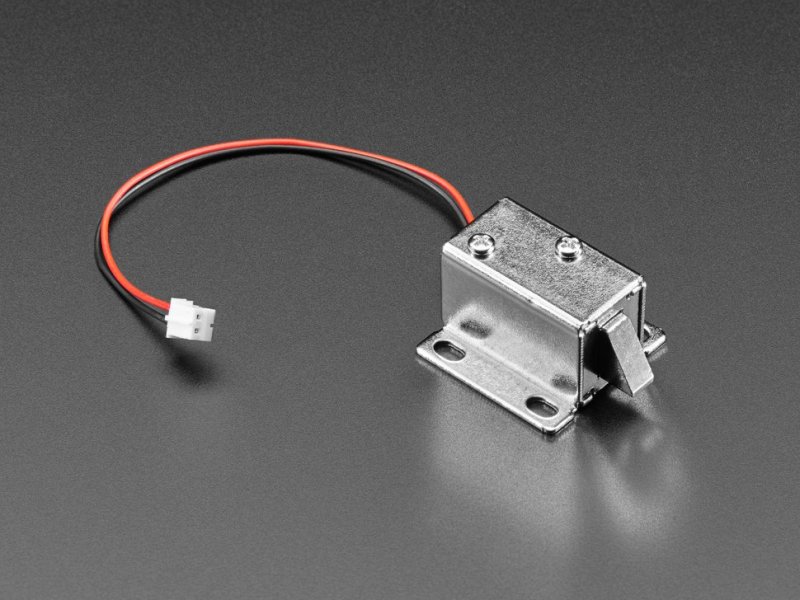



If you want to control access to someplace via computer or microcontroller, e.g. Arduino, then you're going to need some kind of lock which can be opened and closed electronically.
You should show respect for Murphy's law while designing your system. In other words, there should be another way past the lock when the electronic system isn't working, and it should fail gracefully... which probably means that the lock locks when the power fails. What is "right" will of course depend on the details of your project, though. But you don't want to be locked inside your home during a power failure, do you? (Power failures sometimes accompany fires, for instance.) But if the power fails, you also probably want to prevent entry to your home, unless the visitor has a key.
Etc. Why are things never simple? Anyway... back to the component...
One solution to electronic access control is built around magnets which keep doors shut when they are energized. But I prefer electromechanical strike plates.
The "lock" side of your locking mechanism is left as it was before. You change the "hole" that the bolt from the lock engages, the "strike plate".
The replacement strike plate will hold the bolt from the lock, securing the door, except when electricity is fed to the strike plate. When the strike plate is energized, the door can be pushed open.
One of the beauties of using this approach is that it will be relatively easy to switch things back to how they were before if your electronic access solution proves unsatisfactory. Also, the quality of the alternative mechanical lock on the other "side" of this solution is independent of the electronic side.
Suppliers and their web pages come and go. I used Google, searching on "electromechanical strike plate", and came up with the following....
... which were quite expensive! (I won't promise that those links are current, but you can re-search!)
On another occasion I searched with Google and at eBay and Amazon on "electric door lock release", and came up with many more reasonably priced offerings... two for under $23 on a subsequent search, Oct 2012.
Hurrah! Something for the "toy" maker! At last! 8/21, the UK distributor, CoolComponents, made me aware of two devices Adafruit... a well established, reliable, vendor. They were (and still are, as far as I know) offering two more modest devices for the person building an electronic lock. They are similar to one another- both are solenoid-operated latches. One is "small"; the other is more robust. At 8/21, they cost $7.50 and $15. (plus p&p, taxes, 8/21). With the "big" latch style solenoid, you can "turn" the bolt, so that, for instance, you can re-configure it to go on the top edge of a door, vs the edge opposite the hinges. (For more strength than the device can offer, you could build a lock in which activation of the solenoid made it possible to draw a more substantial "bolt" back, and thus "free" the door to open.)
The beveled end allows you to push the door shut, but you'll need to energise the solenoid to re-open the door.
Both are 12v devices, high current (compared to what microporcessors expect) high inductance devices. I.e., they are "dangerous" in the same ways that relays are. (That's the same link as the one I give in the material further down the page
DO NOTE: A system built around one of these would not be fail safe. Not without significant effort. (A second "door", secured one of the old fashioned ways, would be one solution.) But nice prices!...
With many questions of design, the secret is in "boiling things down". The electronics of your access control solution do not need to know much about the electro-mechanical strike plate you are using.
Whether you are using the electromagnet system I dismissed at the start of this note, or the strike plate replacement I recommend, "it" just has two wires to connect. It is as simple as a light bulb.... indeed, for testing, you could put a light bulb in place of the locking mechanism. If you are using the magnet, "bulb on" is equivalent to "door locked", and with the strike plate, "bulb on" is equivalent to "door un-locked".
The locking mechanism you have chosen will come with "specs" ("specifications"). It will say something like "12v AC, 800mA".
"All" you need to do is to arrange for your circuits to supply the right voltage... and right type of voltage (AC or DC)... to the device, from a power supply capable of delivering however much current the specs demand, 800mA in the example above.
If in doubt, use a separate supply for the locking mechanism, and control the supply of the voltage to the lock via a relay. I've done separate notes for you about using relays.
Even if you don't use a relay (or opto-isolator) to separate your electronics from the locking mechanism, be sure you include "The Diode". The same sort as is necessary with relays. Both of the locking mechanism discussed here have electromagnets in them, and so both will generate pulses of negative voltage when they are switched off, the same way the electromagnet in a relay does. (You will also include "the diode" if you DO use a relay, won't you?) "The Diode" is explained in my relays page.
(One of these could probably be connected to a NoviceGuard daughter board, but it would require a second and carefully- kept- separate power supply. I have to confess that I have not done it... yet.
(A little aside to finish off with: You will sometimes find that a strike plate will work with AC or with DC. A little reckless, if the strike plate specs don't say it is okay... but you may be able to turn a "buzzing" strike plate into a silent one. But you may also create one that overheats.)
Why do people always ask that? Well, maybe not you Gentle Reader, but I bet you know the sort who do?
If you want a neat controller for turning the electro-mechanical strikeplate on and off, consider RFID tags. Sparkfun have some neat readers, from Innovations, for about $30, which interface nicely to an Arduino (or other microprocessor), and they also supply a tiny glass encapsulated RFID tag which happens to fit nearly perfectly a fortuitous cavity in the underside of my watch strap....
And how about this for a neat way to carry an RFID tag with you everyday? The central photo shows the tag. It is a small glass capsule. Sparkfun sell them in this form for about $5. My watch strap just happens to have a little cavity, just the perfect size, on its underside.

They also sell a small "button" (no holes, alas) which could easily be sewn into the cuff of a garment, and "credit card" sized tags are available too, of course.
Details of connecting the reader to an Arduino at my page about the RFID reader.
![]() Page tested for compliance with INDUSTRY (not MS-only) standards, using the free, publicly accessible validator at validator.w3.org
Page tested for compliance with INDUSTRY (not MS-only) standards, using the free, publicly accessible validator at validator.w3.org
....... P a g e . . . E n d s .....